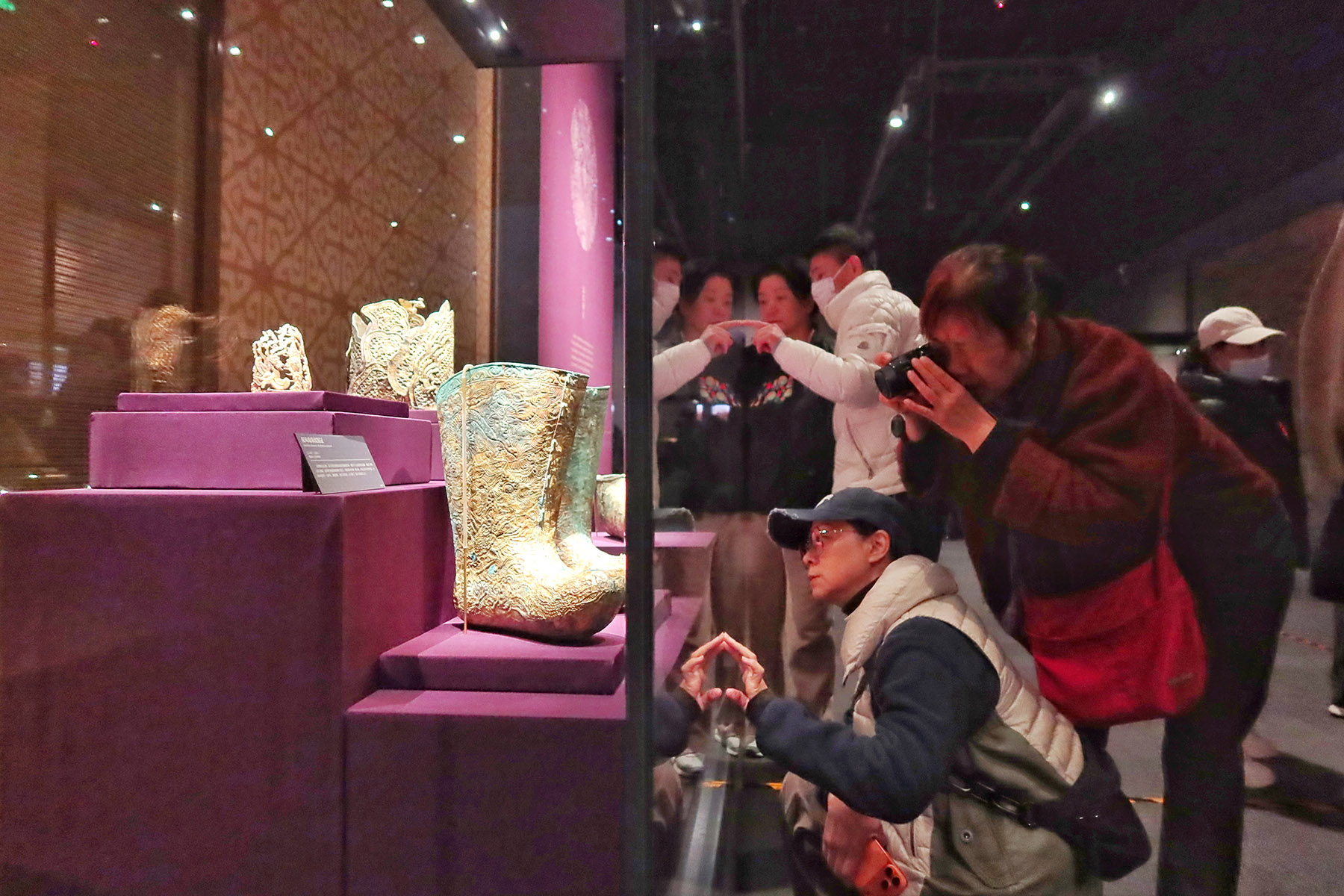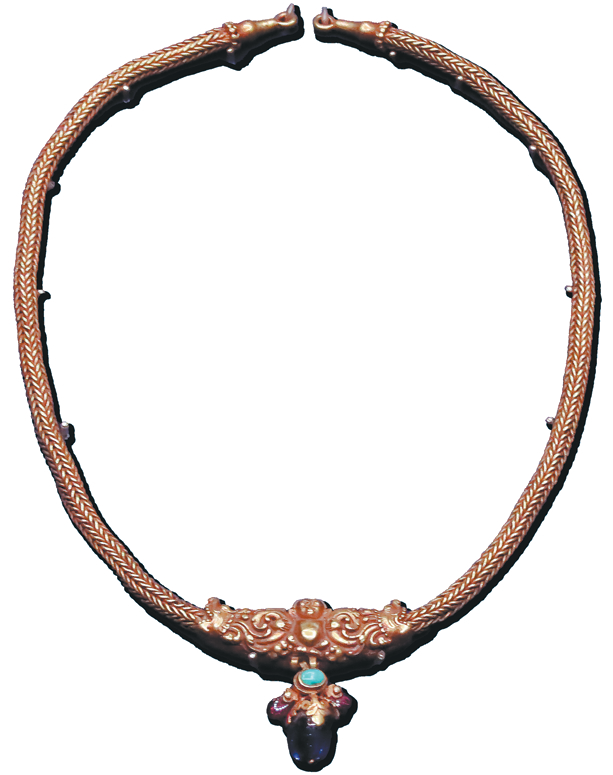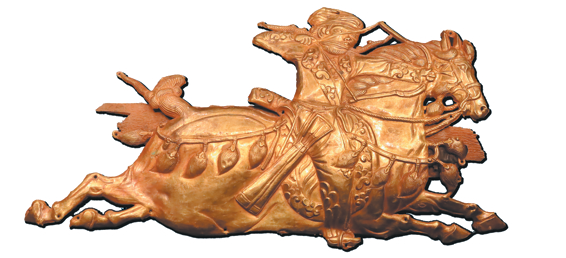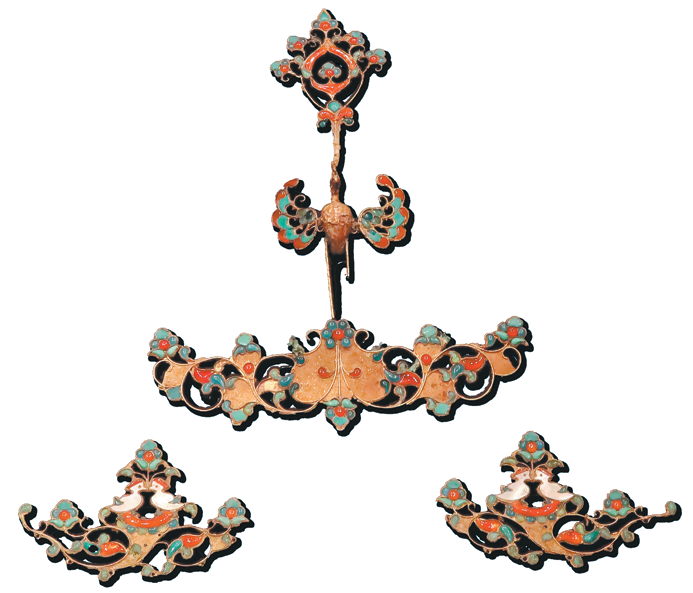New exhibition displays seldom-seen artifacts, telling the Chinese history of this revered yellow metal, Wang Ru reports.

Gold, with its scarcity and stability over millennia, has unified the aesthetics of almost all cultures throughout human history. Exhibitions featuring gold organized by the Capital Museum in Beijing, such as one showcasing gold objects from the mausoleum of the Western Han Dynasty (206 BC-AD 24) Marquis of Haihun and another displaying gold artifacts from the Sanxingdui site, believed to be a capital of the ancient Shu state more than 4,000 years ago in present-day Guanghan, Sichuan province, have always been popular among the public.
Now, gold lovers can feast their eyes on more gold objects at the ongoing Radiance: Ancient Gold Ornaments from the Mengdiexuan Collection of the Hong Kong Palace Museum, an exhibition that kicked off at the Capital Museum on Oct 22 and runs until March 1.
The Hong Kong Palace Museum's Mengdiexuan collection was donated by private collectors. The exhibition showcases over 170 gold ornaments from the 15th century BC to the Ming Dynasty (1368-1644).None of these artifacts has ever been displayed on the Chinese mainland.
READ MORE: Passion for collecting
According to Zhao Jing, curator of the exhibition at the Capital Museum, by showcasing the remarkable achievements of China's 3,000-year-old gold artistry, the exhibition systematically combs through the production, use, and spread of gold in the Eurasian grasslands, China's Central Plains and the Qinghai-Tibet Plateau chronologically, unveiling gold's role as a significant witness to civilizational communication and integration.

The display opens with a section about the introduction of gold to China from the Eurasian Steppe, revealing the close interactions between the steppe and China's Central Plains.
Daisy Yiyou Wang, deputy director of the Hong Kong Palace Museum, says that in ancient times, the elite of the steppe and those from China's Central Plains used different symbols to indicate their identities. While the former favored gold ornaments with animal motifs, the latter preferred bronze and jade artifacts.
However, following exchanges in the Zhou (c. 11th century-256 BC), Qin (221-206 BC), and Han (206 BC-AD 220) dynasties, elites from the Central Plains appeared to have started using gold in daily life and rituals.
On display are two gold rings, each featuring an opening with trumpet-shaped ends. They are believed to be nose rings or armlets from around the 15th to 13th centuries BC.

Artifacts of this type are typical in the Bronze Age Andronovo cultural sites from Central Asia, according to the curators. But they have also been found in sites of the Siba culture from about 18th to 15th centuries BC in the Hexi Corridor (the main artery of the ancient Silk Road in Gansu province) and the Lower Xiajiadian culture from about 16th to 13th centuries BC around the Yanshan Mountains, indicating the possible introduction of gold objects from northern pastoral cultures to China's agricultural cultures.
"Unlike paintings, which may have inscriptions indicating their origins, when checking gold ornaments, we compare their artistic styles, use of materials, and gold-smithing techniques to judge their relations. Through such comparisons, we believe early in Chinese history, China had a very close relationship with the West, Central and South Asia," says Wang.
The second section of the exhibition displays gold artifacts from the Tang Dynasty (618-907) and the Tubo regime, which ruled the Qinghai-Tibet Plateau from the 7th to the 9th centuries.
"It's a short period, but we have a lot of beautiful artworks. You can really see the characteristics of the gold ornaments from that period; everything is big and splashy, spectacular and beautiful," says Wang.

A plaque, in the shape of a dynamic mounted archer galloping on a horse, is one of the outstanding artifacts from Tubo. The archer has two braided strands of hair streaming back with the wind. The horse's tail is tied in a decorative knot, and the leaf ornaments on the breast strap and crupper flutter dramatically, amplifying its dynamic energy.
Zhao mentions that the style of this plaque recalls imperial hunting scenes found on gold and silver wares from the Sassanid Empire (224-651) in West Asia, but the rider's attire and facial features are distinctly Tubo, and display a blend of exotic artistic traditions with Tubo elements.
Benefiting from the convenient transportation network of the ancient Silk Road, Tubo adopted multicultural elements from China's Central Plains, and South, Central, and West Asia, says Wang, who adds that the Silk Road also brought opportunities for the Tang to absorb foreign cultures.
This section also features cultural exchanges between the Tang and Tubo.
"Tang and Tubo coexisted for a long time, during which gold played an important role in their close relationship. It was recorded that gold objects were among the gifts from Tubo to Tang rulers, and gold pieces from Tang also arrived in Tubo through marriage alliances.
"We show some of the objects from Tang, and some from Tubo. You can see they are similar, but also very different. Together, they show an exchange of techniques and aesthetics at that time. That's why we say Chinese civilization is integrated, yet pluralistic," says Wang.

The last section highlights gold ornaments from China's 10th to 17th centuries, developed by different ruling ethnic groups, including Khitan, Mongolian and Tangut.
Guo Jingning, director of the Capital Museum, explains that gold has three peaks of development in Chinese history. The exhibition's three sections basically correspond with the three stages.
"The first peak appeared during the Shang (c. 16th century-11th century BC) and Zhou dynasties, exemplified by gold artifacts from the Sanxingdui site. The second was from the Tang and Song (960-1279) dynasties, during which gold wares from the Hejiacun hoard in Xi'an, Shaanxi province, serve as outstanding examples. The final one was the Ming and Qing (1644-1911) dynasties, represented by gold artifacts from the mausoleum of Emperor Wanli of the Ming period," says Guo.
Two exhibitions featuring similar groups of objects were held in Hong Kong in 2013 and 2023. This time, although the exhibits remain mostly unchanged, researchers from the Capital Museum conducted extensive research on the artifacts. They delved into historical literature and compared the items with similar findings from archaeological excavations, and were, therefore, able to provide more detailed information, according to Wang.
ALSO READ: Mainland, HKSAR join hands to showcase timeless charm of ancient Chinese gold art

This display marks another cooperation between Chinese mainland and Chinese Hong Kong museums, a partnership that has become increasingly frequent in recent years.
The Hong Kong Palace Museum has signed more than 10 memoranda of understanding with mainland museums and universities, and co-organized over 10 exhibitions and academic activities with the Palace Museum in Beijing.
In partnership with museums in Sichuan, the Hong Kong museum organized an exhibition to showcase the newest archaeological discoveries from the Sanxingdui site in 2023 and 2024, which became one of the most popular exhibitions in its history.
"The Hong Kong Palace Museum was established as a collaborative project between Hong Kong's West Kowloon Cultural District Authority and the Palace Museum in Beijing. Therefore, we have the responsibility to tell wonderful stories of Chinese culture through our collaboration with museums on the Chinese mainland," says Wang.
Contact the writer at wangru1@chinadaily.com.cn


